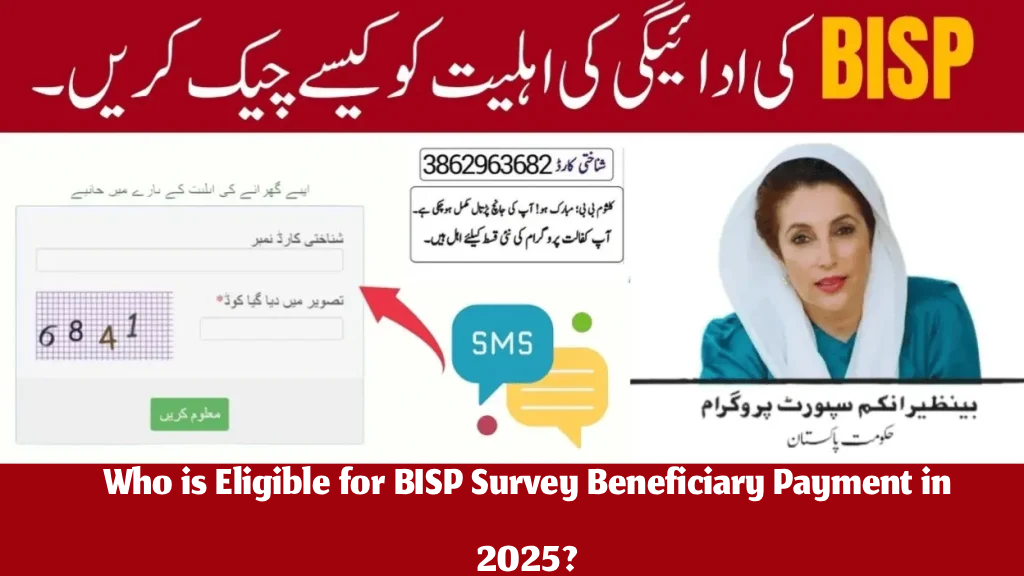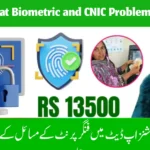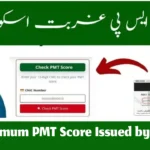
Your Friendly Guide to BISP Payments
Hey there! If you’ve heard about the Benazir Income Support Programme (BISP) in Pakistan and are wondering who is eligible for BISP survey beneficiary payment, you’re in the right place! Imagine this: you’re sitting with a cup of tea, and I’m explaining this like we’re best pals. BISP is like a big, warm hug from the government to help families who need a little extra support. It gives out cash (yep, Rs. 13,500 every three months in 2025!) to help cover things like food, school fees, or even medicine. But who gets this money? How do you sign up? And what’s this “survey” everyone’s talking about? Let’s break it all down in super simple words, so you’ll know exactly what to do by the end of this article.
What is BISP, Anyway?
Before we dive into who qualifies, let’s chat about what BISP is. The Benazir Income Support Programme is Pakistan’s biggest social safety net. Think of it as a program that hands out cash to families who are struggling to make ends meet. It started back in 2008, and in 2025, it’s helping over 9 million families! The main goal? To make life easier for people dealing with poverty, especially women, by giving them money every three months. Plus, there are cool extras like education stipends for kids and health programs. Sounds pretty great, right? Now, let’s get to the juicy part: who can actually get this cash.
Who Can Get BISP Payments in 2025?
Alright, let’s answer the big question: who is eligible for BISP survey beneficiary payment? The program uses a system called the National Socio-Economic Registry (NSER) survey to figure out who qualifies. This survey is like a giant checklist that looks at how much money your family makes, what you own, and other details to see if you need help. Here’s the breakdown of who can apply:
- Low-Income Families: Your household needs to earn less than Rs. 50,000 per month. If your family is scraping by with daily wages or small jobs, you might qualify.
- Women as Primary Beneficiaries: BISP loves empowering women! Usually, the money goes to the female head of the household, like a mom or wife. If there’s no woman in the house, a man can sometimes apply, but women get priority.
- Valid CNIC: You need a valid Computerized National Identity Card (CNIC) from NADRA. This is super important because it’s how BISP verifies who you are.
- Poverty Score (PMT): The NSER survey gives your household a “Poverty Means Test” (PMT) score from 0 to 100. If your score is 32 or lower, you’re likely eligible. Families with someone who has a disability get a slightly higher cutoff of 37.
- Transgender Inclusion: Big news for 2025! Transgender individuals can now apply if they have a CNIC that says “transgender.” BISP has relaxed some rules to make it easier for them to get help.
- No Government Jobs or Pensions: If someone in your household works for the government or gets a pension, you probably won’t qualify. BISP is for families who don’t have that kind of steady income.
- Not Rich in Assets: If you own fancy stuff like a big car, a huge house, or travel a lot by plane, BISP might say, “Hey, you seem to be doing okay!” They use “exclusion filters” to check things like vehicle ownership.
If this sounds like your family, you’re on the right track! But hold up—there’s a catch. You need to complete the NSER survey to prove you qualify. Let’s talk about that next.
What’s the NSER Survey and Why Does It Matter?
Okay, picture this: the NSER survey is like a big interview where BISP asks about your life. It’s called the National Socio-Economic Registry, and it’s how they decide who gets the money. They started collecting data way back in 2010, and by 2025, they’ve got info on 35 million households! That’s a lot of families.
Here’s how it works:
- Door-to-Door or Desk-Based: In the past, BISP workers would knock on doors to ask questions. Now, you can go to a BISP Tehsil Office or a registration center to do the survey. They use something called Computer Assisted Personal Interviewing (CAPI), which is just a fancy way of saying they type your answers into a computer.
- 13 Questions: The survey asks about stuff like how many people live in your house, what you own (like a fridge or a bike), and how much you spend on things like food or electricity. It’s not a test, so don’t stress—just be honest!
- NADRA Verification: After you answer, BISP checks your info with NADRA (the ID card people) to make sure everything matches, like your name and CNIC.
- Dynamic Registry: In 2025, BISP is using a “dynamic registry,” which means you can update your info anytime if something changes, like if you move or have a new baby. But full resurveys happen every few years.
If you pass the survey (meaning your PMT score is low enough), you’re in! You’ll get a confirmation SMS from 8171, and the cash will start rolling in every three months.
Latest Updates for BISP in 2025
BISP is always tweaking things to make the program better. Here are the coolest updates for 2025 that you need to know:
- Bigger Payments: The quarterly payment is now Rs. 13,500, up from Rs. 10,500. That’s more money for groceries, school supplies, or whatever you need!
- New Banking Model: BISP is teaming up with banks like HBL and Bank Alfalah to make payments smoother. You can withdraw cash using biometric verification (fancy fingerprint scans) at ATMs, bank counters, or even JazzCash/EasyPaisa shops.
- Mandatory Re-Survey: If you’ve been getting BISP money for three years or more, you have to do a re-survey by June 30, 2025. If you skip it, your payments might stop. No pressure, but mark your calendar!
- Transgender Inclusion: As mentioned, transgender folks can now join the program with fewer hurdles. This is a big step toward fairness.
- Benazir Taleemi Wazaif Expansion: This is a bonus program where kids of BISP families get extra cash for going to school. In 2025, it’s available in 100 districts, and the stipends are higher to keep kids in class.
- Benazir Nashonuma Centers: These centers help pregnant women and kids under 2 with nutrition and health support. If you’re a mom-to-be, this could be a game-changer.
These updates show BISP is serious about helping more people in smarter ways. Now, let’s talk about how you actually sign up.
Step-by-Step Guide to Apply for BISP Payments
Ready to get started? Applying for BISP is easier than you might think. Here’s a step-by-step guide that’s as simple as making a sandwich:
- Check Your Eligibility: Send your CNIC number to 8171 via SMS. You’ll get a reply saying if you’re eligible or if you need to do the survey. You can also check online at the 8171 web portal.
- Visit a BISP Tehsil Office: Find the nearest BISP office or registration center. Bring your original CNIC, and if you have kids, bring their B-Form (a document from NADRA). If you’re updating your info, bring a recent utility bill to prove your address.
- Get a Token: At the office, you’ll get a token number, like when you’re waiting at a busy restaurant. If you’re pregnant, disabled, or a senior, you might get to skip the line.
- Complete the NSER Survey: Sit down with a BISP officer who’ll ask those 13 questions about your household. Be honest—it’s the best way to make sure you qualify.
- Wait for Confirmation: After the survey, BISP checks your info with NADRA. You’ll get an SMS from 8171 saying if you’re approved. This might take a few days.
- Collect Your Cash: If approved, you’ll get Rs. 13,500 every three months. You can pick it up at a bank (like HBL or Bank Alfalah), an ATM, or a payment campsite. Just bring your CNIC and do a quick fingerprint scan.
Pro tip: Always use the official 8171 number or the 8171 web portal. If someone calls from a different number asking for money or info, it’s probably a scam. Stay sharp!
Benefits of Being a BISP Beneficiary
So, why should you bother signing up? Well, BISP isn’t just about cash—it’s about making life a little easier. Here are some awesome benefits:
- Financial Relief: Rs. 13,500 every three months can help pay for groceries, rent, or school fees. It’s like a safety net for tough times.
- Empowering Women: Since the money usually goes to women, it gives them more control over family finances. That’s a big deal in a lot of households!
- Education Support: The Benazir Taleemi Wazaif program gives extra cash to kids who stay in school. It’s like a reward for hitting the books.
- Health and Nutrition: Programs like Benazir Nashonuma help moms and babies stay healthy with food and medical support.
- Skill Training: Some BISP programs, like Waseela-e-Rozgar, offer free job training. Imagine learning a new skill to earn more money!
- Emergency Help: If there’s a flood, earthquake, or other disaster, BISP might give extra cash to help you get back on your feet.
It’s like BISP is saying, “We’ve got your back!” for all sorts of situations.
Common Mistakes to Avoid When Applying for BISP
Nobody’s perfect, right? But when it comes to BISP, a few slip-ups can slow things down. Here’s what not to do:
- Using an Expired CNIC: Make sure your CNIC is valid. If it’s expired, head to NADRA to renew it before applying.
- Giving Wrong Info: If you fib about your income or assets, BISP will figure it out when they check with NADRA. Honesty is the way to go.
- Ignoring the Re-Survey Deadline: If you’re a long-time beneficiary, don’t skip the mandatory re-survey by June 30, 2025. Your payments could stop!
- Falling for Scams: If someone asks for a fee to “register” you or calls from a number other than 8171, run the other way. BISP services are free.
- Not Updating Info: If you move, get married, or have a new kid, update your NSER details at a BISP office. Outdated info can mess up your eligibility.
- Skipping Biometric Verification: Some payments need a fingerprint scan. If your fingerprints don’t match NADRA’s records, you might face delays.
Avoid these mistakes, and you’ll be smooth sailing toward your Rs. 13,500.
How to Check Your BISP Payment Status
Once you’re approved, you’ll want to know when that cash is coming. Here’s how to check your payment status like a pro:
- SMS Method: Text your CNIC number to 8171. You’ll get a reply telling you if your payment is ready or if there’s an issue.
- Online Portal: Visit the 8171 web portal, enter your CNIC, and type the captcha code (those squiggly letters). It’ll show your eligibility and payment status.
- BISP Helpline: Call 0800-26477 if you’re stuck. The helpline is free and super helpful for sorting out problems.
- Visit a BISP Office: If you’re not getting texts or online updates, pop into a Tehsil office and ask an officer to check for you.
Check your status regularly, especially before the payment dates in January, April, July, and October. That way, you won’t miss out.
What If You’re Not Eligible? Don’t Give Up!
So, what if you do the survey and BISP says, “Sorry, you don’t qualify”? Don’t lose hope! Here’s what you can do:
- Update Your Info: If your situation changes (like losing a job or moving to a smaller house), visit a BISP office to update your NSER survey. The dynamic registry lets you try again.
- Appeal a Decision: If you think BISP made a mistake, file a complaint at a Tehsil office or call the helpline (0800-26477). They’ll review your case.
- Check Other Programs: BISP isn’t the only game in town. Look into programs like the Ehsaas Program or Punjab Socio-Economic Registry for other ways to get help.
- Get Your CNIC: If you don’t have a valid CNIC, go to NADRA to get one. It’s the key to applying for BISP and other support programs.
Keep trying, and don’t be afraid to ask for help at a BISP office. They’re there to make things easier.
Fun Facts About BISP You Didn’t Know
Alright, let’s lighten things up with some cool tidbits about BISP:
- It’s named after Benazir Bhutto, a former Prime Minister of Pakistan who cared a lot about helping people.
- BISP is one of the biggest programs of its kind in the world, helping over 9 million families in 2025!
- The program works with big organizations like the World Bank and Asian Development Bank to make sure it runs smoothly.
- BISP has a super cool E-Kacheri system where you can video chat with officers to solve problems. It’s like Zoom, but for cash!
Pretty neat, huh? BISP is doing some big things to make life better for millions.
Conclusion: You’ve Got This!
And there you have it—a complete guide to who is eligible for BISP survey beneficiary payment in 2025! Whether you’re a mom trying to feed your kids, a family hit by tough times, or someone who just needs a little boost, BISP is here to help. Just grab your CNIC, head to a BISP office, and do the NSER survey. With Rs. 13,500 every three months, plus extras like education and health support, you can make life a bit easier. Don’t forget to check your status, avoid scams, and update your info if things change. You’re not alone—BISP and its team are rooting for you! So, go for it, and let’s make 2025 a year of new possibilities.
FAQs About BISP Eligibility and Payments
1. How do I know if I’m eligible for BISP?
Send your CNIC number to 8171 via SMS or check the 8171 web portal. You’ll need to do the NSER survey to confirm your eligibility based on your income and PMT score.
2. What documents do I need for the NSER survey?
Bring your valid CNIC, your kids’ B-Form (if you have kids), and a recent utility bill to prove your address. Originals only—photocopies might cause delays.
3. How much money will I get from BISP in 2025?
Eligible families get Rs. 13,500 every three months (quarterly). Kids in the Taleemi Wazaif program might get extra stipends for school.
4. What happens if I miss the re-survey deadline?
If you’ve been a beneficiary for three years or more and miss the June 30, 2025, re-survey, your payments might stop until you complete it.
5. Can men apply for BISP payments?
Usually, women are the primary beneficiaries, but if there’s no woman in the household, a man can apply. Transgender individuals with a CNIC are also eligible.
6. What if I don’t get my payment on time?
Check your status on the 8171 portal or call the helpline (0800-26477). It could be a biometric issue or a delay in processing. Don’t panic—just follow up!

